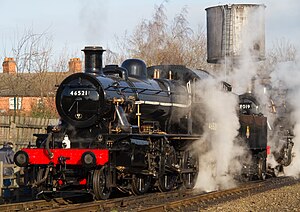LMS Class 2MT 2-6-0
| LMS Ivatt Class 2 2-6-0 | |||||||||||||||||||||||||||||||||||||||||||||||
|---|---|---|---|---|---|---|---|---|---|---|---|---|---|---|---|---|---|---|---|---|---|---|---|---|---|---|---|---|---|---|---|---|---|---|---|---|---|---|---|---|---|---|---|---|---|---|---|

46521 Ivatt class at Loughborough railway station, 28 January 2012. Photo by Tony Hisgett.
|
|||||||||||||||||||||||||||||||||||||||||||||||
|
|||||||||||||||||||||||||||||||||||||||||||||||
|
|||||||||||||||||||||||||||||||||||||||||||||||
|
|||||||||||||||||||||||||||||||||||||||||||||||
|
|||||||||||||||||||||||||||||||||||||||||||||||
| Type and origin | |
|---|---|
| Power type | Steam |
| Designer | H. G. Ivatt |
| Builder |
|
| Build date | 1946–1953 |
| Total produced | 128 |
| Specifications | |
|---|---|
| Configuration: |
|
| • Whyte | 2-6-0 |
| • UIC | 1′C h2 |
| Gauge | 4 ft 8 1⁄2 in (1,435 mm) standard gauge |
| Leading dia. | 3 ft 0 in (0.914 m) |
| Driver dia. | 5 ft 0 in (1.524 m) |
| Length | 53 ft 1 3⁄4 in (16.20 m) |
| Loco weight | 47.10 long tons (47.9 t; 52.8 short tons) (6400–64) 48.45 long tons (49.2 t) (remainder) |
| Tender weight | 37.15 long tons (37.7 t; 41.6 short tons) |
| Fuel type | Coal |
| Fuel capacity | 4 long tons (4.1 t; 4.5 short tons) |
| Water cap | 3,000 imp gal (14,000 l; 3,600 US gal) |
| Firebox: • Firegrate area |
17 1⁄2 sq ft (1.63 m2) |
| Boiler | LMS type 7 |
| Boiler pressure | 200 lbf/in2 (1.38 MPa) |
| Heating surface: • Tubes |
924 sq ft (85.8 m2) |
| • Firebox | 101 sq ft (9.4 m2) |
| Superheater: |
|
| • Heating area | 134 sq ft (12.4 m2) or 124 sq ft (11.5 m2) |
| Cylinders | Two, outside |
| Cylinder size | 16 in × 24 in (406 mm × 610 mm) |
| Valve gear | Walschaerts |
| Performance figures | |
|---|---|
| Tractive effort | 17,410 lbf (77.44 kN) |
| Career | |
|---|---|
| Operators | |
| Power class |
|
| Numbers |
|
| Nicknames | Mickey Mouse |
| Axle load class | BR: Route Availability 2 |
| Withdrawn | 1961–1967 |
| Disposition | 7 preserved, remainder scrapped |
The London, Midland and Scottish Railway (LMS) Ivatt Class 2 2-6-0 is a class of steam locomotive designed for light mixed traffic.
Elderly 0-6-0s formed the backbone of the low-powered locomotives within the LMS fleet. William Stanier had concentrated on introducing larger engines and it was left to George Ivatt to introduce a new class of low-powered locomotive. He designed a tender version of the Ivatt Class 2 2-6-2T, introduced at the same time, which was inspired by the Stanier Class 3 2-6-2T, which was inspired by the Fowler Class 3 2-6-2T. The 2-6-0s had greater range: 3,000 imperial gallons or 14,000 litres or 3,600 US gallons of water and 4 long tons or 4.1 tonnes or 4.5 short tons of coal compared to the tank design's 1,350 imperial gallons or 6,100 litres or 1,620 US gallons and 3 long tons or 3.05 tonnes or 3.36 short tons. So they were well-suited to their task and, following attention to draughting problems by both Derby and Swindon, quickly became a success. Further engines of this type were built as the BR standard class 2 2-6-0, these locomotives having BR standard fittings and a modified cab and tender profile to allow completely unrestricted route availability; both LMS and BR 2MT moguls are often nicknamed "Mickey Mouse".
A total of 128 were built between 1946 and 1953, mostly at Crewe. 20 were built by LMS and given the numbers 6400–19. On nationalisation in 1948 40000 was added to their numbers to become 46400–19. The remaining 108 locomotives of the class, numbered 46420–46527 were built by British Railways, and from 46465 (Darlington, 1951) an increase in cylinder diameter of 1⁄2 inch (13 mm) yielded a tractive effort of 18,510 lb (8,400 kg), 1,100 lb (500 kg) greater than the original design. The LMS classified them 2F, BR as 2MT.
The 38 members of the Darlington-built batch (46465 to 46502) were allocated to the Eastern and North Eastern Regions of British Railways. The final 25 (46503 to 46527) were built at Swindon Works and, being allocated to the Western Region, consequently carried the GWR-type vacuum ejector and firehole doors. The Swindon locomotives were turned out, initially, in lined black. Under the Hanks regime, some received lined green livery as they passed through works. The rest carried black livery. None of the class was named in service, however some have been named in preservation.
...
Wikipedia
